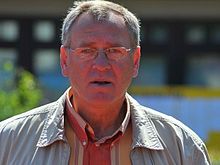 | ||||||||||||||||||||||||||||||
| Personal information | ||||||||||||||||||||||||||||||
|---|---|---|---|---|---|---|---|---|---|---|---|---|---|---|---|---|---|---|---|---|---|---|---|---|---|---|---|---|---|---|
| Nationality | Latvian | |||||||||||||||||||||||||||||
| Born | 28 April 1959 (1959-04-28) (age 65) Tukums, Latvian SSR, Soviet Union | |||||||||||||||||||||||||||||
| Height | 1.98 m (6 ft 6 in) | |||||||||||||||||||||||||||||
| Weight | 90 kg (198 lb) | |||||||||||||||||||||||||||||
| Sport | ||||||||||||||||||||||||||||||
| Country | ||||||||||||||||||||||||||||||
| Sport | Athletics | |||||||||||||||||||||||||||||
| Event | Javelin throw | |||||||||||||||||||||||||||||
| Achievements and titles | ||||||||||||||||||||||||||||||
| Personal best | 92.06 m (1980) | |||||||||||||||||||||||||||||
Medal record
| ||||||||||||||||||||||||||||||
Dainis Kūla (born 28 April 1959 in Tukums, Latvian SSR) is a Latvian former javelin thrower who represented the Soviet Union at the international level for most of his career. He is most famous for controversially winning the gold medal in men's javelin throw at the 1980 Summer Olympics, becoming the second Latvian to achieve this (after Jānis Lūsis). He is also a World Championship bronze medalist, a three-time Soviet Champion and a two-time Universiade champion.
1980 Summer Olympics
Early in the training season for the 1980 Summer Olympics, Kūla threw 90.30 meters and in the run-up to the Olympics, he threw even farther: 92.06 meters, a mark he would never exceed in an official competition. The favorite though was Hungary's formidable Ferenc Paragi, who had thrown a new world record of 96.72 in April.
At the Olympics in Moscow, Kūla cleared the qualification stage easily but fouled on both of his first two throws in the final. As only the top eight of twelve finalists would be allowed the full six attempts, this meant everything hung on his third throw. Although the third throw flew far, it apparently landed flat and failed to pierce the field, which meant it too should have been ruled illegal. However, in front of the home crowd, the officials raised a white flag indicating that the throw was good; it was measured at 88.88, easily enough to advance him to the last three rounds (indeed taking the lead at that point). On his fourth throw, Kūla threw 91.20 meters, the only mark in the competition to exceed 90 m, giving him the Olympic gold. The silver went to Aleksandr Makarov with a last-round mark of 89.64, giving the Soviet Union both of the top spots, while Wolfgang Hanisch of East Germany took the bronze medal. The pre-competition favorite Paragi had led the qualification with 88.76, but only managed 79.52 during the first three rounds in the final and had to be content with 10th place, missing the last rounds.
With the old javelin design still in use at the time, throws frequently landed flat or ambiguously, resulting in questionable official judgements. Kūla's case has gained particular notoriety as it landed him with an Olympic gold, and also because it could easily be seen as Soviet officials favoring their own athlete. (There were other claims of this occurring in the javelin final, including an allegation that the stadium gates were opened to let helping wind in whenever Soviets were throwing, and that Kūla's important third throw had not only been misjudged but mismeasured as well.) However, none of these controversies resulted in any official protest.
Further career
Kūla won his second major championship medal, a bronze, at the Helsinki World Championships in Athletics of 1983. His best throw in the rainy final was 85.58 meters, only two centimeters short of American Tom Petranoff's silver throw. This was the smallest margin possible at the time not relying on second-best throws as a tie-breaker, as javelin throws have only been officially measured with one centimeter accuracy since 1998. Petranoff, who had thrown a new world record of 99.72 earlier that year, and the eventual winner Detlef Michel of East Germany had been the pre-meet favorites.
In 1984, Kūla severely injured his hand and was less successful after the injury. In 1988 he was released from the Soviet team, however he continued to compete internationally up until the 1993 World Championships in Athletics in Stuttgart, by then representing his native Latvia. He failed to achieve any noticeable success there, as none of his throws crossed the 75 meter line.
References
- "Soviet Championships". Athletics Weekly.
- ^ Siukonen, Markku; et al. (1980). Urheilutieto 5 (in Finnish). Oy Scandia Kirjat Ab. ISBN 951-9466-20-7.
- Erich Bremicker. "Why did the senior javelin specification have to be changed?". Archived from the original on 23 September 2018. Retrieved 27 December 2009.
- "IAAF Statistics Handbook" (PDF). 2009. Archived from the original (PDF) on 5 June 2011.
- "1993 IAAF World Championships results". IAAF. Archived from the original on 14 February 2010.
External links
- Dainis Kūla at World Athletics

- Dainis Kūla at the Latvian Athletics Association (in Latvian)

- Dainis Kūla at Olympics.com

- Dainis Kūla at Olympedia

- Dainis Kūla at the Latvijas Olimpiskā komiteja (in Latvian) (English translation, archive)
| Olympic champions in men's javelin throw | |
|---|---|
|
| World University Games champions in men's javelin throw | |
|---|---|
|
| IAAF World / Continental Cup champions in men's javelin throw | |
|---|---|
|
- 1959 births
- Living people
- People from Tukums
- Latvian male javelin throwers
- Soviet male javelin throwers
- Athletes (track and field) at the 1980 Summer Olympics
- Olympic athletes for the Soviet Union
- Olympic gold medalists for the Soviet Union
- World Athletics Championships medalists
- Medalists at the 1980 Summer Olympics
- Olympic gold medalists in athletics (track and field)
- Universiade medalists in athletics (track and field)
- FISU World University Games gold medalists for the Soviet Union
- Medalists at the 1981 Summer Universiade
- Medalists at the 1983 Summer Universiade